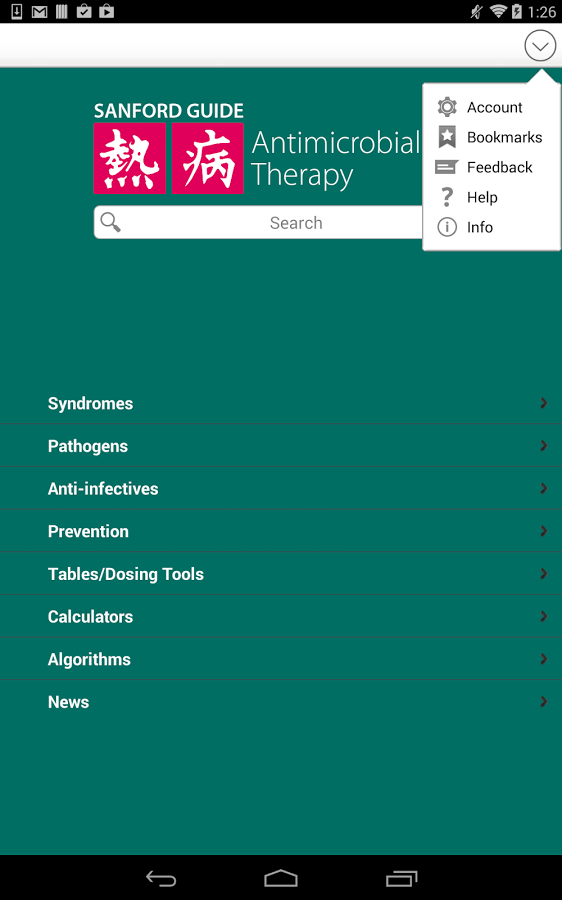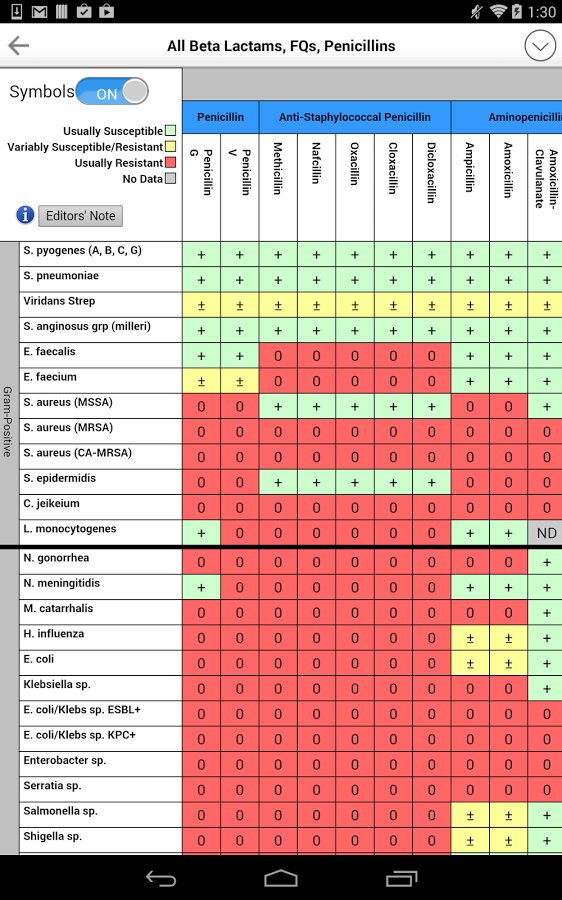
- Sanford Guide To Antimicrobial Therapy 2013 Free Pdf
- Sanford Guide To Antimicrobial Therapy Free Pdf
- Sanford Guide To Antimicrobial Therapy 2011 Pdf Free Download
Number: 0215 Policy. Aetna considers outpatient intravenous antibiotic therapy medically necessary in adult and pediatric members with the diagnosis of Lyme disease only when it is based on the clinical presentation of signs and symptoms compatible with the disease and supported by a positive serologic and/or cerebrospinal fluid (CSF) titer by indirect immunofluorescence assay (IFA), Prevue Borrelia burgdorferi antibody detection assay, or enzyme-linked immunosorbent assay (ELISA), which itself is validated by a positive Western Blot Test (see CDC criteria in note below). Once a definitive diagnosis of Lyme disease is established, Aetna considers an initial 4-week course of outpatient intravenous antibiotic therapy medically necessary when any of the following conditions is met:. Stage II Lyme disease with early dissemination documented by organ-specific manifestations of infection (arthritic, cardiac, or neurologic). Stage III late Lyme disease documented by findings of arthritis and/or neurologic complications, such as encephalomyelitis and subacute encephalitis. Aetna considers initial intravenous antibiotic therapy experimental and investigational for the following indications, because the benefit of intravenous antibiotic therapy for these indications has not been established:.
The member has completed an initial course of appropriate intravenous antibiotic therapy; and. The member has objective evidence of either relapse of infection, progression of Lyme disease organ damage, and/or the finding of a new focus or type of organ damage. Aetna considers additional antibiotic therapy in post-treatment, persistently fatigued patients (post-Lyme disease syndrome) experimental and investigational because intravenous antibiotic therapy has not been shown to be effective for this indication. Concurrent babesiosis or cat-scratch disease is not, in and of itself, considered a medically necessary indication for long-term intravenous antibiotic therapy for Lyme disease.
Long-term intravenous antibiotic therapy is generally not medically necessary in immunocompetent persons with Bartonella-associated vasculo-proliferative diseases (bacillary angiomatosis-peliosis and verruga peruana) or Bartonella bacteriemia (other than Bartonella endocarditis). Intravenous antibiotic therapy may be medically necessary in persons with severe Bartonella infection, immunocompromised persons, and systemic Bartonella infection complicated by bony or parenchymal involvement or endocarditis. Aetna considers hyperbaric oxygen therapy experimental and investigational for the treatment of Lyme disease because its effectiveness for this indication has not been established (see ). Aetna considers intravenous antibiotic therapy experimental and investigational for the treatment of Q fever because its effectiveness over oral antibiotics for this indication has not been established. Aetna considers testing ticks for Borrelia burgdorferi experimental and investigational because it has not been proven to be useful for deciding if a person should receive medical treatment following a tick bite.
Aetna considers singlet oxygen therapy experimental and investigational for the treatment of Lyme disease because of a lack of evidence regarding its effectiveness. Aetna considers chelation therapy experimental and investigational for the treatment of Lyme disease because of a lack of evidence regarding its effectiveness. Aetna considers intravenous ascorbic acid or intravenous magnesium experimental and investigational for the treatment of Lyme disease because of a lack of evidence regarding their effectiveness. Aetna considers the use of alpha lipoic acid or “Healing Detox Drips” for the treatment of Lyme disease experimental and investigational because of insufficient evidence of its effectiveness.
Aetna considers intramuscular antibiotic for the treatment of Lyme disease experimental and investigational because of insufficient evidence of its effectiveness. Footnote for CDC.
Note: According to the CDC (1995), the recommended method for serologic detection of active disease or previous infection involves a 2-test approach using a sensitive enzyme immunoassay (EIA) or IFA followed by a Western immunoblot. All specimens positive or equivocal by a sensitive EIA or IFA should be tested by a standardized Western immunoblot. The CDC (1995) states that when Western immunoblot is used during the first 4 weeks of disease onset (early LD), both immunoglobulin M (IgM) and immunoglobulin G (IgG) procedures should be performed. However, a positive IgM immunoblot alone is not considered sufficient evidence of active disease in a person with Lyme disease of more than 1 month's duration. Although the presence of IgM antibodies is useful in evaluating early disease, the CDC states that a positive IgM test result alone is not recommended for use in determining active disease in persons with illness greater than 1 month's duration because the likelihood of a false-positive test result for a current infection is high for these persons. The following criteria for a positive Western Blot are adapted from the CDC (1995): IgM immunoblot - 2 of the following bands are present:. A positive serology, on its own, is not considered a medically necessary indication for antibiotic therapy for Lyme disease.
According to the CDC, positive antibody tests should be correlated with symptoms to be clinically meaningful. According to the CDC (1995), if an individual with suspected early Lyme disease has a negative serology, serologic evidence of infection is best obtained by testing of paired acute- and convalescent-phase serum samples.

Serum samples from persons with disseminated or late-stage Lyme disease almost always have a strong IgG response to Borrelia burgdorferi antigens. Footnote for OspC. The apparent molecular mass of outer surface protein C (OspC) is strain-dependent; thus the 21 kDa, 22 kDa, 23 kDa, and 24 kDa proteins referred to above are the same. See also.,.,. and. Background The use and duration of intravenous antibiotic therapy in Lyme disease (LD) remains controversial.
Researchers are currently conducting studies to assess the optimal duration of antibiotic therapy for the various manifestations of LD. In some areas of the country, patients are being treated for months to 1 year or more with daily parenteral or oral antibiotics. In a randomized controlled study, Wormser et al (2003) stated that treatment of patients with early LD has trended toward longer duration despite the absence of supporting clinical trials.
These investigators concluded that extending treatment with doxycycline from 10 to 20 days or adding 1 dose of ceftriaxone to the beginning of a 10-day course of doxycycline did not enhance therapeutic efficacy in patients with erythema migrans. Regardless of regimen, objective evidence of treatment failure was extremely rare.
In the largest long-term study of outcomes based on treatment duration in patients with early LD, Kowalski et al (2010) found that patients treated for 10 days with antibiotic therapy for early LD have long-term outcomes similar to those of patients treated with longer courses. The investigators found that treatment failure after appropriately targeted short-course therapy, if it occurs, is exceedingly rare. Kowalski et al (2010) reported on the long-term clinical outcomes of patients with early localized and early disseminated LD based on the duration of antibiotic therapy prescribed. These investigators reported on a retrospective cohort study and follow-up survey of patients diagnosed as having early localized and early disseminated LD from January 1, 2000 through December 31, 2004 was conducted in a LD-hyperendemic area. A total of 607 patients met the study inclusion criteria.
Most patients (93%) were treated with doxycycline for treatment durations of 10 days, 11 to 15 days, or 16 days in 17%, 33%, and 47% of doxycycline-treated patients, respectively. Treatment failure criteria, defined before performing the study, were met in only 6 patients (1%). Although these 6 patients met a priori treatment failure criteria, 4 of these patients' clinical details suggested re-infection, 1 was treated with an inappropriate antibiotic, and 1 developed facial palsy early in therapy. Re-infection developed in 4% of patients. The 2-year treatment failure-free survival rates of patients treated with antibiotics for 10 days, 11 to 15 days, or 16 days were 99.0%, 98.9%, and 99.2%, respectively. Multiple measures of long-term function - including pain, general health, and emotional and physical well-being - were similar among groups. The only statistically significant difference was decreased social functioning in the group of patients with the longest treatment duration.
Randomized controlled studies of treatment of patients who remain unwell after standard courses of antibiotic therapy for LD have shown that repeated or prolonged courses of antibiotic therapy are not effective for such patients. Krupp et al (2003) reported that ceftriaxone therapy in patients with post-Lyme syndrome (PLS) with severe fatigue was associated with an improvement in fatigue but not with cognitive function or an experimental laboratory measure of infection. Because fatigue (a non-specific symptom) was the only outcome that improved and because treatment was associated with adverse events, these authors concluded that their findings did not support the use of additional antibiotic therapy with intravenous ceftriaxone in post-treatment, persistently fatigued patients with PLS. This in agreement with the findings of Kaplan et al (2003) who concluded that patients with post-treatment chronic Lyme disease who have symptoms (e.g., fatigue, depression) but show no evidence of persisting Borrelia infection do not show objective evidence of cognitive impairment.
Sanford Guide To Antimicrobial Therapy 2013 Free Pdf
Additional antibiotic therapy was not more beneficial than administering placebo. Added expense and toxicity are the only proven results of such practice. Iatrogenic problems, such as gallbladder disease, fungal infections, and other superinfections, and gastrointestinal problems, certainly increase with prolonged use of broad-spectrum antibiotics. This highlights the need for an appropriate diagnosis before subjecting the patient to antibiotic regimens.
Sanford Guide To Antimicrobial Therapy Free Pdf
In a randomized, controlled clinical trial, a prolonged course of antibiotics produced no sustained benefit in persons with Lyme encephalopathy. Fallon et al (2008) reported on a randomized, placebo-controlled trial assessing the efficacy of a 10-week course of intravenous ceftriaxone in patients with a history of clinical LD, as well as current serologic evidence of Borrelia burgdorferi infection, greater than 3 weeks of previous intravenous ceftriaxone therapy completed greater than 4 months before study entry, and objective evidence of memory impairment (but no history of a condition that could confound neuropsychological assessment).
Sanford Guide To Antimicrobial Therapy 2011 Pdf Free Download
A total of 37 patients with Lyme encephalopathy (out of 3,368 individuals who were screened) were enrolled. Additionally, 20 healthy control subjects were included to correct for practice effects from repeated neurocognitive testing. Neuropsychological testing (assessment of motor function, psychomotor function, attention, memory, working memory, and verbal fluency) was conducted at baseline and at weeks 12 and 24 after study entry. At 12 weeks, ceftriaxone recipients showed better cognitive improvement than did placebo recipients (p = 0.053) or healthy controls (p.